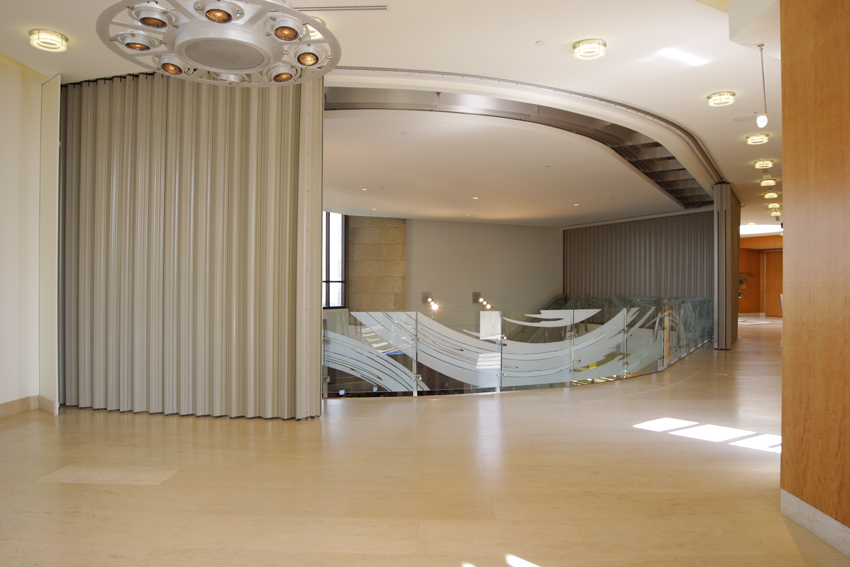Horizontal Sliding Fire Doors: Architectural Design Freedom
Design Possibilities
By allowing openings to appear unencumbered, sliding door systems provide practical answers to fire and egress code requirements while allowing extraordinary architectural versatility. Many museum architects have determined that horizontal sliding door systems solve the problem of meeting fire and building codes while maintaining open vistas between large vertical and horizontal internal spaces. For the Bilbao Guggenheim Museum, Gehry Partners used 10 fire-rated horizontal accordion-style sliding doors totaling 3,000 square feet to deliver interior spaces that aptly reflect the dramatic forms of the exterior. For the J. Paul Getty Museum at the Getty Center in Los Angeles, Richard Meier and his firm Richard Meier & Partners specified 64 doors or more than 6,600 square feet of sliding doors as invisible fire breaks that allow people to move freely between the exhibition spaces.
Sliding door systems have a range of applications in a multitude of building types. Some serve several code-compliance functions at once, such as providing exits and protecting vertical openings, elevator lobby separations, and remote security monitoring capabilities, plus permitting multilevel fire-rated design features. In sum, they provide “area separation,” a reference much in use but now outdated as a code term. Applications for code compliance include:
- Fire wall separation
- Fire barriers
- Shaft enclosures
- Fire partitions
- Smoke partitions

Photos courtesy of Jim Roof Creative Inc.
Horizontal sliding fire doors with an integrated pocket cover door and compressed stack panels can reduce pocket depth by 50 percent.
In high-rise buildings, sliding fire door systems are often the least expensive means of separating the elevator lobby from the remainder of the building and to provide egress doors as required by code. Sliding fire doors can maximize the opening into the elevator lobby and minimize any design constraints associated with accommodating doors swinging into the elevator lobby or encroaching on exit corridors.
Sliding door systems are found in Marriott, Hyatt, Walt Disney World, Ritz Carlton, and Hilton hotels. They also provide for open and easy accessibility to the gaming floors in many Las Vegas hotels. Caesar’s Palace, for instance, has a concealed specially engineered 32-foot-7-inch-high 1.5-hour sliding fire door separating the multimillion-dollar Roman Forum shopping mall from the casino’s main gaming area (noting the heavy track system and proposed construction modifications, UL issued an oversized special door certificate).
Sliding doors deliver spaciousness and open access in megaplexes, as well as provide fire separation walls required to compartmentalize the area. Some sliding fire door systems in shopping malls and sports facilities reach 100 feet in width when open. At the other end of the spectrum, sliding door assemblies have been used at the entrance of parking garages where there was insufficient height for a typical roll-down fire shutter.

Photo courtesy of Michael Dersin Photography
Sliding doors keep corridors open for moving travelers but will separate areas in an emergency.
In addition to being fire-code compliant, sliding door systems offer security against break-ins. In one California shopping mall, burglars succeeded in breaking through traditional roll-down gates, but their crowbars failed to dislodge the steel sliding door assembly installed in a fire separation upgrade at the entrance to the mall.
Concealed sliding fire-rated door systems that can also seal off sections to separate occupants are an ideal solution in airports whose business is to move many thousands of travelers quickly. The addition of the International Terminal at Baltimore/Washington International Airport required an area separation between the new and old terminal. RTKL of Baltimore, which provided a package of regionally sensitive graphic materials and a comprehensive set of tenant criteria, protected the wide span openings with a sliding fire door. The door assembly allows an unobstructed flow of airport traffic by remaining in the open position and yet having the capability to automatically close when the building fire alarm system is activated. Sliding fire door systems are also found in Orlando International Airport, Charlotte Douglas, Newark, San Diego, Ronald Reagan Washington International, and many other airports.

Photo courtesy of Promotional Design Associates
Invisibly hidden in pocket doors when open, a curved sliding door offers fire protection for the interior stairway.
Inspired by the Bilbao Guggenheim Museum, the 42,000-square-foot Cerritos Library addition by CWA AIA Inc. of Glendale, California, is a library of the future. With three floors wrapped in a skin of titanium that allows fluid compound curve, the building is the first titanium-clad structure in the United States. It contains 1,200 Internet ports, hundreds of computer workstations, plus a 15,000-gallon saltwater aquarium. A wide span curving sliding fire door system provides invisible protection for the interior stairways. With no floor track, a sliding door system provides invisible vertical separation of the third floor.
Expansions and renovations to historic buildings invariably involve solving code requirements relating to stairwells, staircases, and issues arising from combining the old with the new. Concealed curved sliding fire doors will provide vertical separation, protect staircases, and maintain openness.










